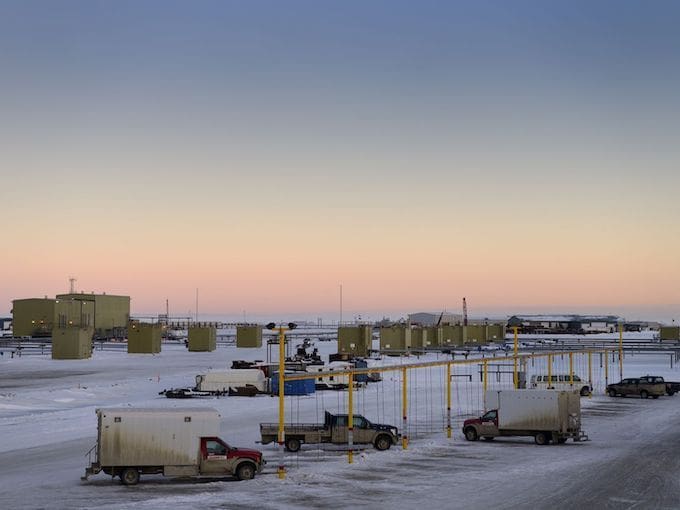What if we just give people money?
This is the question propelling several new books and that’s been taken up by more than one presidential candidate — foremost Andrew Yang, who has made universal basic income (UBI) the centerpiece of his campaign. An automated future looms on the horizon, and tech magnates and policy wonks are turning to UBI as a neat solution to the messy problem of technology-induced unemployment.
Yet when one considers the political ramifications of the largest and longest-running UBI experiment in America — Alaska’s Permanent Fund Dividend (PFD) — giving out cash appears to create unforeseen problems, and advocates for basic income would do well to incorporate Alaska’s latest experience into their conceptions of the policy.
Since 1982, Alaska has been giving every woman, man, and child an annual chunk of its nest egg: the $66.3 billion Permanent Fund. Alaska deposits at least 25 percent of mineral royalties — revenue the state generates from its mines, oil, and gas reserves — into the fund annually. The money is in turn invested by the Alaska Permanent Fund Corporation in domestic and global stock, bonds, private equity, and more, and interest earnings are then distributed to Alaska residents every September.
Former Gov. Jay Hammond, the mastermind behind the fund, created the dividend system as a way to ensure Alaska’s nonrenewable resources could provide an everlasting return to the state. In his words, he “wanted to transform oil wells pumping oil for a finite period into money wells pumping money for infinity.” Paying out $1,000 to $2,000 per person per year — every Alaskan gets the same amount — was Hammond’s plan to protect the fund. If every Alaskan were a stakeholder in the Permanent Fund’s future, surely no politician could dismantle it without paying an electoral price.
For decades, Hammond’s system was an unprecedented success. But in 2015, plunging oil prices created major shortfalls in the state’s budget. In response, then-Gov. Bill Walker deviated from the traditional PFD formula and reduced the value of the check for 2016. Doing so allowed the government to continue funding state services and ensured the sustainability of the fund. Instead of a check for $2,052, as they would have received with the traditional formula, Alaskans that year got a comparatively paltry $1,022.
In 2018, Republican state Sen. Mike Dunleavy saw an opportunity. Despite traditional Republican aversions to handouts, Dunleavy ran for governor on the campaign platform of increasing the PFD. He promised every resident up to $6,700, to make up for Walker’s cuts in 2016 and 2017 — though he was foggy on how the state could pay.
The result? Dunleavy won by a landslide.
The problem is that he now finds himself unable to fulfill his campaign promise without major cuts elsewhere. He’s now seeking to jettison other state commitments to health care, education, infrastructure, and other vital areas. After initially vetoing $444 million from the state budget, Dunleavy responded to the threat of a recall vote and walked back some of his more extreme line-item cuts. Still, the state will see no funding for public broadcasting, a 31 percent cut to its critical ferry system, $130 million from Medicaid, and $70 million from the University of Alaska system.
The PFD allowed Dunleavy to turn the governor’s race into a single-issue vote: Do you want a bigger check or not? The events in Alaska show that a UBI policy can have a dramatic effect on an economy — but it can also overwhelm all other governmental concerns and dominate politics.
The complicated politics of the Alaska Permanent Fund
To supporters of a UBI, the Alaska PFD offers a tantalizing glimpse of what a universal basic income can do. Thanks to the PFD, crippling poverty is scant in Alaska. A 2016 study by the University of Alaska found it reduced poverty up to 20 percent.
However, Alaskans’ finances are insecure in other ways. High unemployment (the highest in the country) and the astronomical cost of rural living meant that even voters who were concerned about the feasibility of Dunleavy’s $6,700 pledge voted for him anyway.
A couple thousand bucks might not sound like basic income, but for many rural Alaskans, a big PFD can mean the difference between a year of hunger and a year of plenty. In the end, Dunleavy’s $6,700 was an offer too high to refuse.
But on top of all the cuts he’s pushed, Dunleavy agreed on August 20 to the $1,600 PFD that was passed by the legislature — meaning Alaskans still won’t get the check they thought they were voting for, because contrary to Dunleavy’s campaign messaging, the governor does not actually hold the power to set the value of the dividend. (Only the legislature does.)
The upheavals in Alaska illustrate how the PFD has come to warp the state’s politics. It has allowed a feckless politician to capitalize on residents’ economic insecurities and reach the state’s highest office. Alaska is one of the closest test cases we have for UBI, and interested parties should note the political and social costs that Alaska’s PFD is accruing. Once a government adopts such a policy, it may well become the preeminent issue in future campaigns. As Anchorage Daily News commentator Charles Wohlforth wrote, “It took only a year or two before the fund became politically sacrosanct.”
Alaska is not a perfect analog to the United States as a whole. The state has no income or sales tax and is loath to implement either. Andrew Yang’s Freedom Dividend plan relies on dedicated tax revenue, which would be subject to fewer vicissitudes than oil markets. It is also improbable the US would find itself in a similar budgetary bind that would pit funding for public services against a UBI. The US can borrow in huge numbers and perform financial wizardry that a lone state cannot.
However, Alaska’s political composition means it is a better test case for UBI than any small-scale randomized controlled trial, since it allows observers to study not only the economic and social ramifications of UBI but also its effects in the political arena. Republicans control the government of Alaska — just as they now control the US federal government — and Republicans tend to defund public services and thwart attempts to raise taxes on the wealthy. Any viable American UBI policy would have to grapple with the same temptations on the part of conservative politicians to use UBI to get elected and then as an excuse to strip public funding from programs they don’t like.
The situation unfolding in Alaska demonstrates how economic precarity, paired with an entrenched reliance on an annual check, can result in deep political dysfunction. How might the government salvage this vital yet troublesome program? Alaskan lawmakers have proposed codifying the formula for the dividend check amount in the state constitution as a way of settling its perennial political battles.
In theory, this would isolate the PFD from opportunistic politicians, but the reality would be more complicated. How exactly to calculate the amount alone is a vexing and deeply political question. Introducing more rigidity to the process might make the state even less adaptable to oil market fluctuations.
None of this is to say Alaska should do away with the PFD, or that UBI activists should abandon their cause. Aspects of the PFD show tremendous promise for a similar nationwide program — it signals the US would see reduced poverty, a buoyed economy, a greater sense of ownership over the country. But these UBI enthusiasts should pay attention to the curdling effects the PFD has had on Alaska’s politics, and how it has left elections vulnerable to candidates willing to make unkeepable promises.
Cash is a uniquely motivating incentive. The Alaska governor’s race indicates UBI would be a mobilizer of votes beyond what other proposals might achieve. And because UBI does not have the same tinge of big government as other entitlements, conservative political movements can readily claim UBI for their own and use it as a cudgel to dismantle public programs. Alaska demonstrates that when you start giving people money, the act may very well eclipse every other political concern and blot out all other missions of government.
Robyn Sundlee is a research fellow at the USC Annenberg Center on Communication Leadership and Policy. She was the campaign manager for Alaska State Rep. Jonathan Kreiss-Tomkins (D) in 2018.
Sign up for the Future Perfect newsletter. Twice a week, you’ll get a roundup of ideas and solutions for tackling our biggest challenges: improving public health, decreasing human and animal suffering, easing catastrophic risks, humanely handling the scourge of feral hogs, and — to put it simply — getting better at doing good.





















